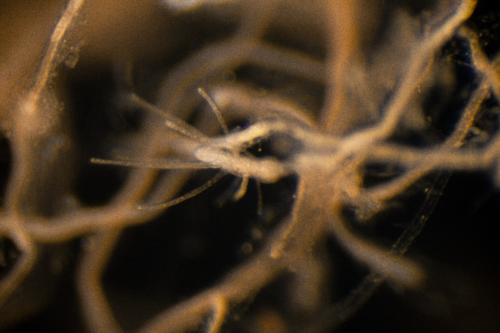Image courtesy of Maria Pascual-Torner.
Many people—and organisms—are familiar with the cycle of life.. Everything goes through various developmental stages—from birth to adulthood, aging, and death. In each case, an organism’s life ends the same way. Experiencing death is inevitable.
This is true for nearly every single living thing except one: the jellyfish Turritopsis dohrnii.
Turritopsis dohrnii (known as T. dohrnii for short) is currently one of the only biologically immortal beings in the world. As T. dohrnii ‘grows up,’ it changes from a polyp (which is coral-like in appearance) to an adult jellyfish (technically called a medusa). But they don’t eventually die of old age. Instead, they head in the reverse direction: shrinking into a blob of mass and reforming until they return to the early polyp stage. The jellyfish continues in this growth and reversal cycle for the rest of time.
Scientists have become fascinated with the mechanisms that allow T. dohrnii to be immortal. One of these scientists is Maria Pascual-Torner, a postdoctoral student at the University de Oviedo. She compared T. dohrnii and its close relative, Turritopsis rubra (T. rubra), another species of jellyfish that is genetically similar to T. dohrnii but is mortal. This research focused on comparing gene structure and gene expression related to aging between the two species by analyzing DNA samples between the two jellyfish and looking at RNA samples of T. dohrnii during its different stages of development. The goal was to find differences across the genomes, which could allow scientists to pinpoint why exactly T. dohrnii is biologically capable of being immortal.
Results of the research showed that some mechanisms related to aging are more efficient in T. dohrnii compared to T. rubra and other species. Specifically, T. dohrnii has enhanced abilities in DNA repair and has strong pathways that allow cells to revert to their initial stages and de-differentiate, meaning that they don’t have a specific role anymore and can become any type of cell.
T. dohrnii also appeared to utilize what is known as the polycomb pathway, which essentially does the work of silencing particular genes that help with development. By stopping development, this pathway stops aging in its tracks. In the future, Pascual-Torner notes that her lab hopes to continue examining this pathway and learning how exactly the T. dohrnii silences these genes.
Researching T. dohrnii was not easy. Both T. dohrnii and T. rubra are incredibly small organisms, so quantities of samples were limited. Because of this, it took more time to conduct an accurate and thorough analysis.
The implications of this research go beyond our knowledge of jellyfish. “These results are now candidates to keep studying aging. If there are some researchers that study Alzheimer’s or cancer, for example, they could check for some of these variants. Our work tries to present new candidates to keep exploring [in these fields],” Pascual-Torner said. However, the research is still very specific to this one species of jellyfish. “All the mechanisms that are in Turritopsis dohrnii make a synergy. All of them, in this kind of organism, work,” Pascual-Torner said.

